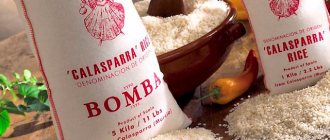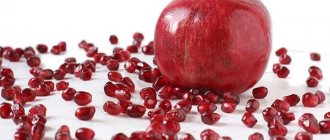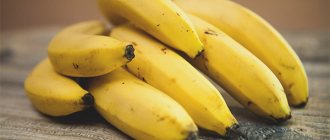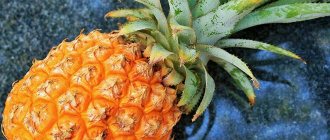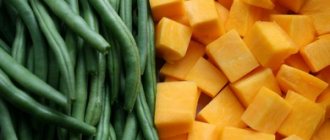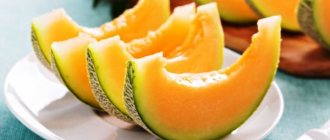Rules for recognizing ripe and unripe fruit
If the purchased fruit turns out to be hard, you need to find out in advance how to store the avocado so that it ripens faster. If all the rules are followed, the fruit does not ripen for long. To distinguish a ripe avocado from an unripe one, you need to pay attention to the color, stem, pit and hardness of the fruit.
Color
Two types of alligator pear are most often eaten: large fruits and small Hass fruits. You can often judge the ripeness of an avocado by the color of its peel:
- dark brown with black spots - the fruit has rotted and deteriorated;
- dark green - the fruit has already ripened;
- light green - the fruit needs ripening, it is almost ready to eat;
- yellowish - the avocado has not yet ripened.
To prevent avocados from being unripe, before purchasing they must not only be inspected, but also touched.
Hardness
The ripeness of the fruit can be determined by its hardness, as well as by the color of the skin. Overripe fruits are too soft; when pressed, dents remain on their surface; it takes a long time to restore their shape.
It is impossible to press on an unripe avocado - the fruit is quite hard.
If the fruit is relatively soft, and after pressing the shape is restored after 15-20 seconds, after 2-3 days, provided that it is properly stored, it can be eaten.
Ripe fruits are moderately soft and regain their shape in a few seconds. Their skin is elastic, without roughness. The softness of the fruit largely depends on the variety of avocado.
Most often found in stores:
- California avocado. The ripe fruit has a hard, dark green or brown skin. The hardness is moderate, the flesh does not spring under your fingers.
- Variety "Pinkerton". Based on the color and thickness of the peel, it is considered a universal type of avocado. The ripe fruit is elongated, quite soft to the touch, with slight roughness on the skin. There is a lot of pulp in it, the bone is small.
- Variety "Florida". Fruits with smooth thin skin of a rich green color. The pulp is dense, ripe fruit retains its shape for a long time.
Completely black fruits (a variety rarely found on sale) have a dense, hard skin and, even when ripe, remain hard to the touch.
By seed and stalk
To increase shelf life and preserve the fruit during long-term transportation, fruits are picked from trees unripe, so a short stalk is often left behind. By its condition you can determine the ripeness of the avocado. Before purchasing, you must tear off the tail and inspect it carefully. A light brown, evenly dried stalk is present only in mature fruits. After removing the stalk, greenish pulp is visible.
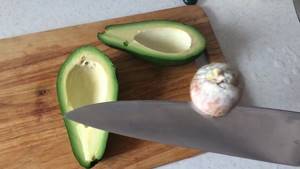
An unripe avocado has a brown-green stem that is difficult to break off. Overripe fruits have a black, dry tail. The size of the seed directly depends on the variety. If the avocado is fully ripe during transportation, its bone core is easily separated from the pulp - just cut the fruit lengthwise and, taking it in your hands, turn the halves in the opposite direction to each other. Remove the pit from unripe fruit with a spoon.
Secrets to softening the fetus
Don't be afraid of buying an avocado that is too hard - this is not a reason to be upset: you need to put it on the windowsill and wait a few days. But there are ways by which fruits become soft in a shorter time. We suggest you learn how to soften an avocado at home.
We recommend that you read: Spring pruning of figs
1 way
Heat treatment will help make the avocado soft in a few minutes. However, it is worth understanding that when exposed to temperatures, some valuable substances in its composition are destroyed. Therefore, it is better to resort to this method only in cases of extreme necessity, for example, if you want to surprise unexpected guests with an original dish.
There are 3 ways to soften an avocado using heat:
- In the oven. Wrap in foil and place in an oven preheated to +90°C for 10 minutes.
- In the microwave. Make several punctures on all sides of the avocado with a fork. Place on a plate, place in the appliance and cover with a plastic lid or napkin. Turn on the device for 30 seconds. If after this time the fruit is not soft enough, heat for another 30 seconds.
- By scalding. This method takes only 2 minutes and is suitable if you need to add avocado to a salad. It must be freed from the skin and pits and cut into strips or slices. Place in a sieve and scald with boiling water.
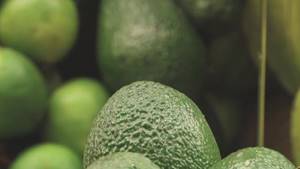
Experienced chefs categorically do not recommend using a microwave. This device will not only deprive the fruit of vitamins, but also special taste qualities, and will also make the consistency of the pulp unsuitable for preparing many dishes. The fruit will only be suitable for making smoothies.
Avocados and some other vegetables and fruits emit a special gas when ripe - ethylene.
If you do not allow this substance to spread into the air, but keep it near the fruit, you can significantly speed up the ripening process. Experienced cooks and housewives recommend resorting to such methods.
Method 2
A hard avocado can be made to ripen faster using this method:
- Place in a paper bag without holes.
- Close the bag with tape or a special clip.
- Keep at a temperature of +18…+24 °C until the fruit ripens.
We recommend that you read Figs in the treatment of gastritis
This method will allow the light green fruit to reach maturity in 2 days.
To speed up the process, you can put a ripe banana, tomato or apple in the bag: the ethylene they release will serve as an additional factor stimulating ripening.
For good results, it is recommended to follow simple tips:
- close the bag tightly so that the resulting gas does not escape;
- do not put the bag in the refrigerator: the lower the temperature, the slower the ripening;
- Do not use a plastic bag: the fruit may spoil or turn sour.
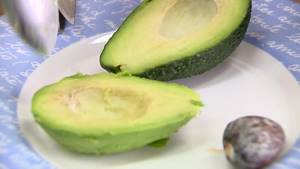
3 way
Sometimes it happens that a cut avocado only seems ripe, but near the pit its flesh is still hard. To save a mistakenly cut specimen from damage and speed up its ripening, you can use this trick:
- Sprinkle the surfaces of the fruit with lemon juice and connect the 2 halves. There is no need to remove the pit.
- Wrap the avocado in cling film and put it in the refrigerator.
How quickly the fruit becomes soft depends on the initial degree of ripeness: the fruit will “reach” in a few hours or a couple of days.
4 way
Another interesting method that will help light green avocados ripen in a couple of days:
- Pour wheat flour into a deep bowl.
- Immerse the fruit in the product and leave at room temperature.
Used flour should not be eaten. But it is suitable, for example, for preparing salt dough for children's crafts.
5 way
Housewives who don’t know what to do with old newspapers use them to speed up the ripening of avocados:
- Wrap the fruit tightly in newspaper.
- Place in a dark place. Leave for several days.
It is recommended to check the fruit a couple of times a day to prevent it from spoiling. It is recommended to keep the fruit in a dry place: moisture promotes rotting.
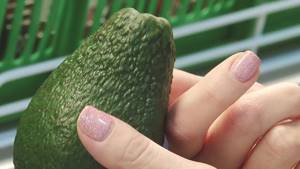
Alligator pear: how to choose the right fruit
The avocado got its unusual name “alligator pear” for its characteristic appearance: the fruit is shaped like a pear, and its color is exactly the same as that of the famous American crocodile - rich green. In addition, the avocado peel itself is not smooth, but ribbed, like the back of an alligator. Despite such a repulsive appearance, avocados enjoy great love both in their homeland - Mexico - and throughout the world in general. This is explained by its beneficial properties.
Green fruits contain a huge amount of healthy oils, vitamins, mineral salts and proteins. Avocado pulp, which tastes like a cross between an egg yolk and a walnut, is highly nutritious, so just one alligator pear can be a complete breakfast or dinner.
Of course, the most valuable properties are possessed by a high-quality, ripe fruit, which is distinguished by characteristic features:
- Softness. The hardness of the fruit indicates that it is not yet ripe, and excessive softness indicates that it is overripe. A good fruit has a medium density, at which you can press the peel with your fingers without leaving lasting marks on it.
- Fruit color. A mature alligator pear is green in color, turning purple in places. A dense specimen with a soft green color will definitely be immature.
- Stalk color. The ripening of the alligator pear is indicated by the yellow stem. A green stem is a sign of insufficient ripeness of the avocado.
If there are ripe fruits on the counter, of course, it is better to choose one of the most attractive ones and purchase it. If all the samples are still green, don’t be upset. After all, avocados can be ripened at home. Therefore, in such a case, you can take any green fruit and buy it to enjoy it later.
Which fruits should you choose?
Fully ripe fruit should be purchased if you plan to consume it within the next few days. The degree of maturity is determined by the structure. When pressing on the fruit, a small dimple should remain on its surface.
- The unripe fruit has a bright green, rather hard peel. It itself is hard to the touch, and its taste is slightly reminiscent of unripe pumpkin. Peeling such an avocado and getting the pit out of it is quite difficult.
- The peel of a ripe fruit has a dark green, uniform color. With the exception of the Hass variety, which is considered the largest and turns black when fully ripe.
- The flesh of a ripe avocado has a yellow-green color and an oily texture, and the pit is easily separated from it when cut.
- The skin of a ripe fruit can be easily removed by hand, and the taste of a ripe avocado cannot be bitter.
It is best to buy fruits intended for storage when their skins are still bright green. When it is dark, the fruit should be consumed within a short time.
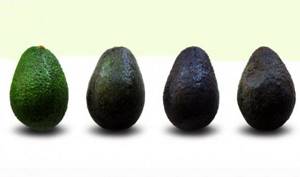
Signs that an avocado is hard
If an avocado is ripe, it is soft. It can be safely used in culinary experiments. The degree of maturity can be checked by the following characteristics:
- Color. A light green tint indicates that the fruit needs approximately 5 more days to ripen. Moderately green - 3 days, deeply green - 24 hours, dark green, close to brown - the fruit is ready for consumption.
- Subjective hardness. If the avocado gives way when pressed, it is soft enough. However, this method is not accurate enough: sometimes the top layer can be soft and tasty, but closer to the bone it can be hard.
- Cutting. Ripeness can also be determined by the condition of the fruit around the cutting: the area should be light yellow. If the shade is light brown, the avocado, on the contrary, is overripe and should not be taken.
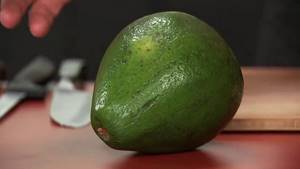
In our country, where avocados are brought from distant countries, buyers see hard fruits on store shelves. But waiting until the goods sold become soft is impractical: good copies will be sold out, leaving spoiled fruit at the bottom of the box.
There are also promotions when you can buy an exotic product at a profit, and it is contraindicated to hesitate here.
However, unripe fruit is not only hard and tasteless, but also dangerous to health. Eating such fruits in large quantities can cause food poisoning.
How to choose an avocado
First, carefully examine the fruit: a ripe avocado has smooth skin, brown spots and dents indicate that the fruit is overripe. Now feel it: it’s too hard - it’s not ripe, it’s limp and flabby - it’s been sitting on the counter. The ripe product is quite soft, but not loose.
Press down on the skin. If the dent immediately straightens out, it means the avocado is ripe. Break the stalk. It is almost impossible to do this in an unripe fetus. An avocado that has begun to deteriorate will reveal dark contents. The perfectly ripe fruit is green inside.
How to buy ripe avocado?
When you are faced with choosing a fruit, you can only guess by its appearance how ripe and juicy it is. A ripe avocado should not be hard or too soft. The first speaks of its unripeness, and the latter - of depravity. The most optimal thing is when you feel elasticity when you press with your finger, you can safely take such an avocado. Pay attention to the color of the peel: the fruit should be green with a purple color without scratches or dents.
Even if you fail to choose a ready-to-eat fruit, you can always find out how an avocado ripens at home. And over time, you will learn to instantly find the fruit of optimal ripeness.
There is another way to determine maturity. Look at the color of the stalk: green or yellow will tell you that the fruit is moderately ripe, while brown is a sign of severe overripeness.
Storage rules at home
The whole fruit is tightly wrapped in food-grade polyethylene, then placed in an airtight container or bag closed with a ziplock, having previously bled the air out of it. Then put it in a cool and dark place.
In a refrigerator
To prevent the avocado from darkening due to oxidation and losing its freshness and density, you can use onions. Cut it into rings and place it on the bottom of the container, with half of the avocado on top, cut side up - this is how the juice will not leak out of it. Seal the container and refrigerate for up to a week.
A similar effect will occur if you smear the cut with freshly squeezed lemon juice and put it in a closed container. This will increase the shelf life to six days.
The pieces, greased with vegetable (olive, refined sunflower) oil, will lie under the lid for five days without darkening.
In the freezer
An avocado will last for six months in the freezer. It is best to first make a puree from it, which can then be used for sauces, spreads on sandwiches, smoothies, and salads.
Method for making puree:
- select ripe fruit;
- wash;
- clear;
- cut, remove the pit;
- thoroughly grind the pulp with a blender, mash with a fork or rub through a sieve;
- place portions in plastic containers or freezer bags;
- pour with lemon or lime juice;
- close with a lid (ziplock);
- to freeze.
You can also simply cut the avocado into pieces, put it in a container, sprinkle with citrus juice and put it in the freezer. It should be remembered that repeated defrosting and freezing is unacceptable.
In the closet
Wrap the avocado in thick packaging or craft paper and put it in a dark closet, where it can be kept for up to seven days. The air temperature should not exceed +22 °C, otherwise the shelf life will be reduced to 72 hours.
It will be possible to store unripe fruit in this way for a little longer. At a temperature of +22–23 °C. It will ripen in about 10 days. When the avocado becomes soft, you need to use it quickly.
Ways to speed up ripening at home
If you purchased an unripe avocado, few people know what to do with it. Often, having tried such a fruit, the desire to consume it in the future disappears. Juicy, soft, well-ripened fruit will delight you with a pleasant taste and rich aroma. Therefore, you need to figure out what you need to do to enjoy a ripe avocado as quickly as possible.
Warming up in the oven
If you follow simple recommendations, the ripening process will go faster. Necessary:
- Wrap the washed fruits in foil.
- Preheat the oven. You will need 200 °C.
- Place the preparations on a baking sheet and place in the oven. Hold for 10 minutes.
High-speed in the microwave
This method is suitable when avocado urgently needs to be added to a dish:
- Peel the fruit. Cut into cubes.
- Place in a heat-resistant container and place in the microwave.
- Warm up on maximum mode for half a minute.
Disadvantages of this method:
- color is lost;
- the aroma becomes less intense;
- a lot of juice is released.
In a paper bag
The gas that promotes fruit ripening is ethylene. The package is a simple trap that can hold him. You can use any store bought or McDonald's. Important rules:
- Place a tomato, apple or banana in the bag along with the avocado. The latter fits best. Fruits emit ethylene in large quantities. Plenty of gas helps it ripen faster. Close the package.
- Store in the room. You cannot put it in the refrigerator. The package should not be exposed to direct sunlight. Ideal temperature is +18…+24 °C.
- Check the contents periodically. If there are other fruits in the package, the avocado will reach technical maturity in 3 days. It's better to check by touch. If an avocado is placed in a bag without other fruits, it will ripen no earlier than in 5 days.
Using newspaper
To ripen an avocado faster, you can use the oldest method - newspaper. How to use:
- Wrap unripe specimens in a sheet of newspaper and place in a warm place.
- A hot, but turned off oven, in which the fruit is placed and left for 2 days, can help ripening.
Storage nuances
1-2 weeks is the shelf life of an avocado. But here we are talking about a semi-ripe whole fruit.
5 recommendations will help extend the storage period of fruit cut in half:
- Do not remove the pit. Half of it will last longer. It prevents oxygen from reaching the fibers.
- Avocados with damaged skin should only be stored in the refrigerator or freezer.
- Contact with air must be limited. To do this, use cling film or a container with a lid.
- The place at the back wall of the refrigerator is the best place to store the “alligator pear”.
- The fruit should be stored strictly with the cut side up - in this position it will not wither so quickly.
There are many ways to preserve the appearance of a cut avocado. Below is a rating of life hacks for increasing shelf life.
Cool the avocado.
Once the avocado is ripe, you can keep it that way longer by placing it in the refrigerator. While this won't stop the ripening process altogether, it will slow it down significantly. Likewise, if you have a lot of avocados and want them to ripen at different times, store them in the refrigerator for a few days before you want them to ripen.
Like apples, avocados quickly oxidize and turn brown. While this doesn't make them inedible, it is aesthetically unpleasing. To store sliced avocados, brush the exposed flesh with lemon juice, cover with cling film, and refrigerate. The acidity of the lemon juice helps stop oxidation, as does limiting the amount of oxygen that comes into contact with the fruit's pulp.
See also: Common mistakes when storing frozen vegetables
How to recognize ripe and unripe fruit
Determining the ripeness of a fruit in a store is not difficult if you know all the distinctive features. But you shouldn’t be upset when buying an unripe specimen. This fruit ripens well at home.
Peel color
The peel and shade of different varieties may vary. Some avocados have a smooth surface, while others have pimples or wrinkles. The degree of maturity is determined by the color of the peel:
- a light green tint indicates that the fruit is not ripe;
- moderately green in color - almost ready to eat, it will ripen on its own in a day;
- with a dark green color, the fruit is ready to eat;
- very dark shade, almost black - the avocado is spoiled.
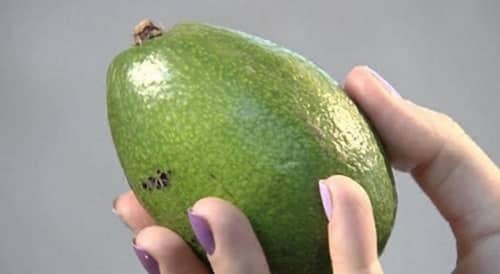
Fruit hardness
If it is not possible to determine the degree of ripeness by the color of the skin, then you can understand by the hardness of the fruit.
- A hard, hard fruit that cannot be pressed is not yet ripe. He will need to lie down for about another week.
- Slightly soft when pressed, the avocado will ripen in a couple of days.
- The fruit is ripe if, with gentle pressure, softness is felt and the fruit is pressed through.
- Overripe ones are too soft and may have dents.
Depending on the variety, the color can be almost any shade. There are completely black fruits, which are among the most delicious; in this variety, ripeness is determined only by hardness.
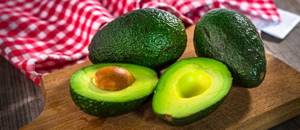
Condition of the seed and stalk
You can check the ripeness of the fruit by examining the cutting. If there is a tail, you need to tear it off. If the stalk is light brown, it means the fruit is ripe. Black color is a sign of overripe fruit, which is not recommended for consumption.
In mature specimens, the stone is easily separated from the pulp; in unripe specimens, the stone is tightly attached and will have to be cut out.
How to make an avocado soft quickly?
If you bought an unripe avocado and are trying to figure out what to do, decide how much time is left until it is consumed or used in a recipe.
Express methods include:
- Microwave (a few minutes);
- Oven (up to ten minutes);
- Boiling water (two minutes).
However, it should be remembered that quick methods affect the quality of taste and consistency of the product; you will have to mask them with the help of other components of the recipe or spices. Suitable for preparing multi-component sauces.
When buying a hard avocado, don’t be upset when you learn how to make it soft. Take advantage of one of the ways to ripen avocados at home quickly and efficiently? Where to put avocados to ripen? And enjoy the range of beneficial properties and unusual recipes available to lovers of the exotic fruit.
- Related Posts
- How long can meat be stored in the refrigerator? Storage conditions and periods
- How to get rid of the smell of fragrant meat?
- How to properly store avocados at home?
« Previous entry
In the oven
Before placing the avocado in the oven, it is wrapped in aluminum foil - tightly and without gaps. The temperature should be 180–200 degrees. Five minutes - and everything is ready. Don't keep it for 10-15 minutes, as some people advise, you'll just bake it! Remove the foil after cooling to avoid burning your hands.
Accelerated methods have a significant disadvantage: after heat treatment, the fruit somewhat changes its natural taste and aroma. Not everyone is happy with this turn of events. But there is no need to be afraid. Despite this, the fruit remains quite suitable for making salads, cocktails, and guacamole.
Sources used:
- https://alltravnik.ru/derevya/dozrevanie-avokado
- https://www.sympaty.net/20190519/kak-dozret-i-xranit-avokado-v-domashnix-usloviyax/
- https://kakxranit.ru/produkti/kak-xranit-avokado.html
- https://alltravnik.ru/derevya/razmyagchaem-avokado
- https://ru.m.wikihow.com/accelerate-ripening-avocado
- https://jlady.ru/domashnee-xozyajstvo/kak-hranit-avocado.html
- https://eda-land.ru/avokado/kak-dozrevaet/
- https://mschistota.ru/storage/xranit-razrezannyj-avokado.html
- https://dachamechty.ru/frukty/kak-dozret-avokado.html
- https://mschistota.ru/ovoshhi-i-frukty/kak-dozret-avokado.html

